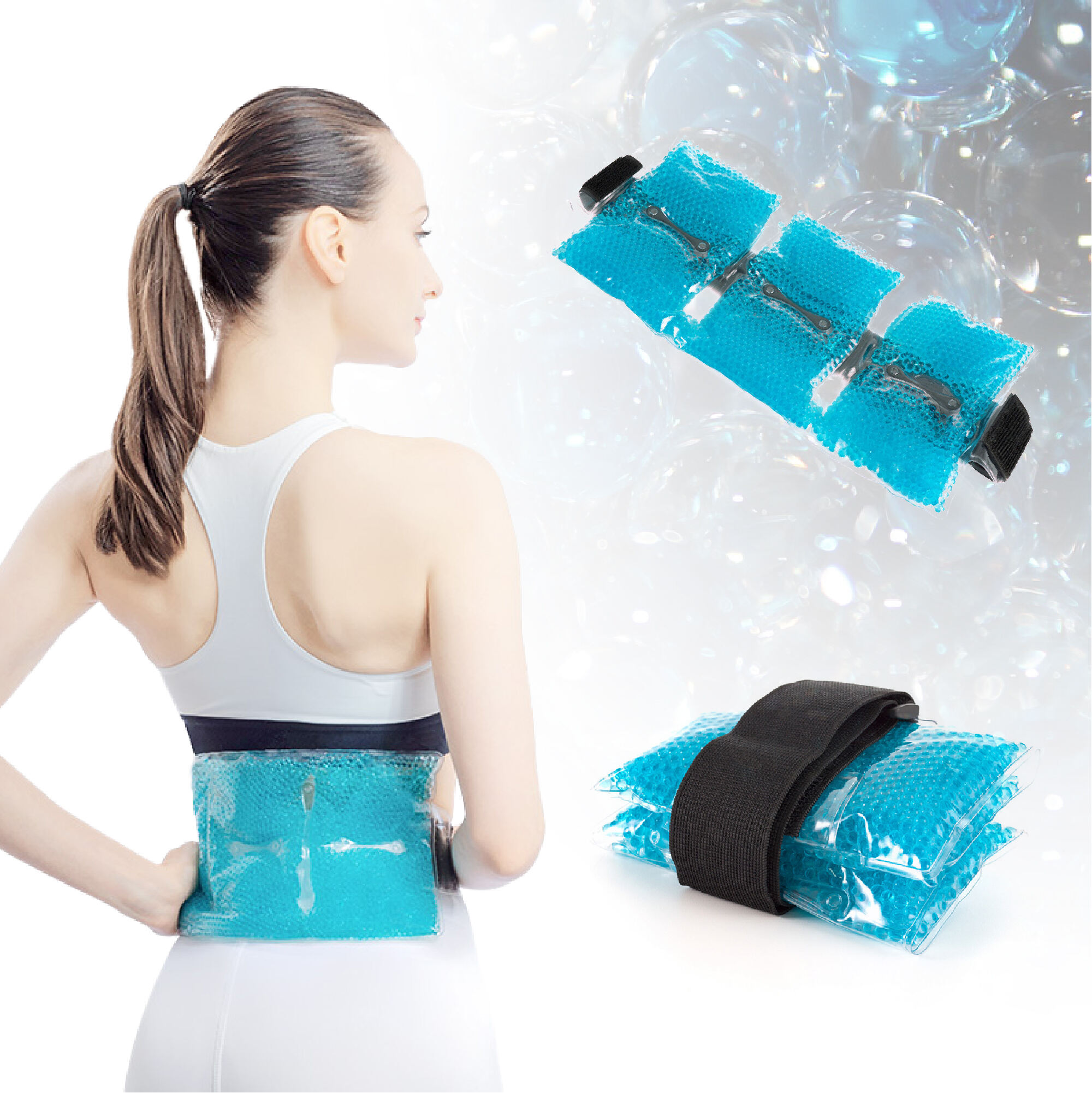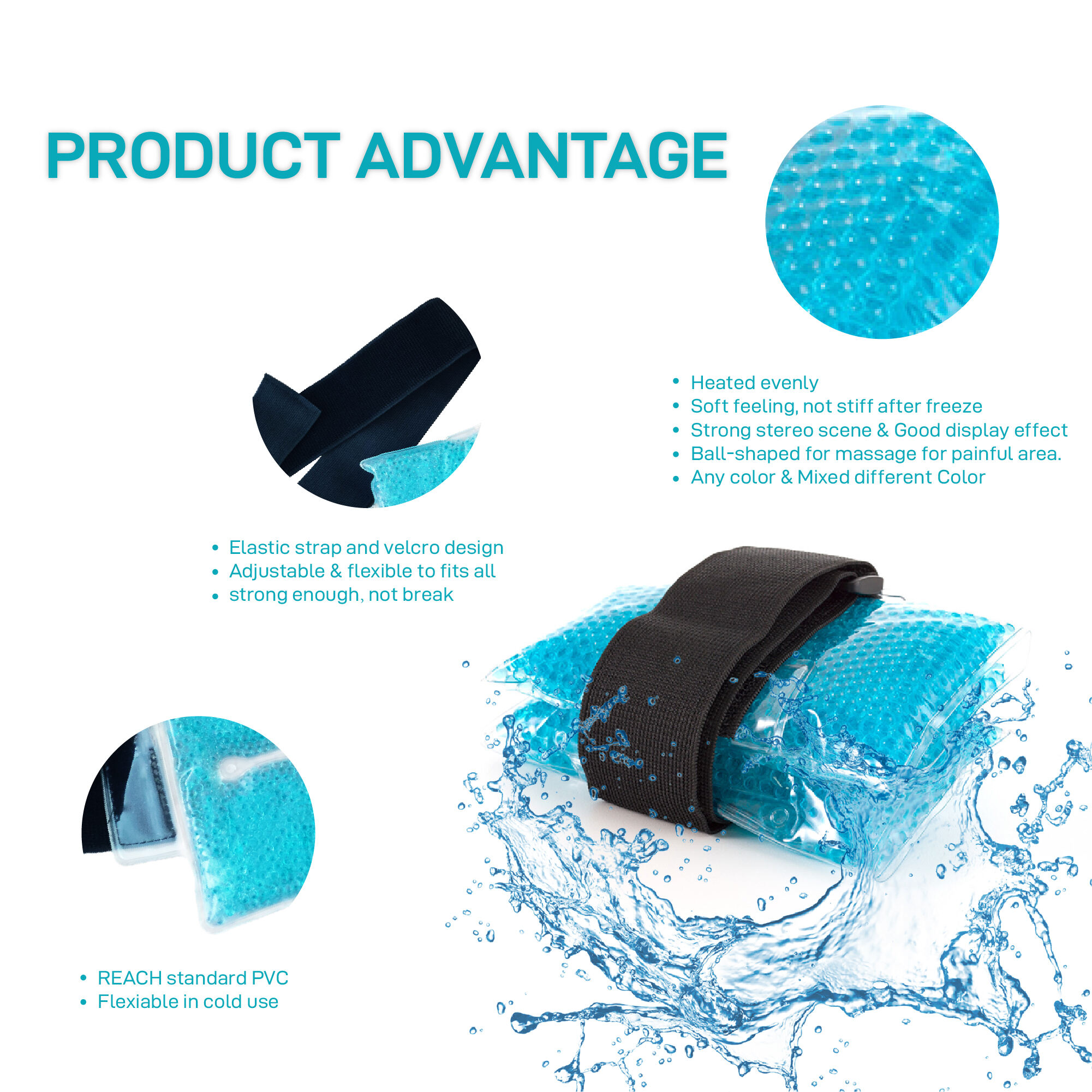วิธีใช้ถุงน้ำเย็นสำหรับการบาดเจ็บจากการเล่นกีฬา
ถุงน้ำแข็ง เป็นเครื่องมือที่เรียบง่ายแต่มีประสิทธิภาพในการรักษาอาการบาดเจ็บจากการเล่นกีฬา ตั้งแต่ข้อเท้าแพลงไปจนถึงกล้ามเนื้อตึง เมื่อใช้อย่างถูกต้อง การประคบเย็นจะช่วยลดอาการปวด บวม และอักเสบ โดยชะลอการไหลเวียนของเลือดไปยังบริเวณที่ได้รับบาดเจ็บ ช่วยให้ร่างกายฟื้นตัวได้เร็วขึ้น อย่างไรก็ตาม การใช้อย่างไม่ถูกต้องอาจทำให้ผิวหนังเสียหายหรือฟื้นตัวได้ช้า การรู้วิธีใช้ ถุงน้ำแข็ง อย่างปลอดภัยและมีประสิทธิภาพคือหัวใจสำคัญสำหรับนักกีฬา โค้ช และผู้ที่กำลังเผชิญกับอาการบาดเจ็บที่เกี่ยวข้องกับกีฬา ลองมาดูขั้นตอนการใช้ถุงน้ำแข็งให้ถูกต้องกันดีกว่า
เมื่อใดควรใช้ถุงน้ำแข็งสำหรับอาการบาดเจ็บจากการเล่นกีฬา
การบำบัดด้วยความเย็น (การบำบัดด้วยไครโอ) จะได้ผลดีที่สุดสำหรับอาการบาดเจ็บเฉียบพลัน ซึ่งเป็นอาการบาดเจ็บที่เกิดขึ้นอย่างกะทันหัน เช่น ข้อเท้าพลิก ล้มกระแทก หรือการกระทบกระแทก อาการบาดเจ็บเหล่านี้มักทำให้เกิดอาการบวม แดง และเจ็บปวด ซึ่งการใช้ถุงน้ำแข็งสามารถช่วยบรรเทาอาการเหล่านี้ได้
อาการบาดเจ็บที่เหมาะกับการใช้ถุงน้ำแข็ง
- ข้อเท้าพลิกหรือกล้ามเนื้อฉีกขาด: อาการข้อเท้าพลิก ข้อเขยวก หรือกล้ามเนื้อฉีกขาด (เช่น กล้ามเนื้อหลังหัวเข่า หรือกล้ามเนื้อน่อง) จะได้รับประโยชน์จากการใช้ถุงน้ำแข็งเพื่อลดอาการบวม
- ฟกช้ำ: การใช้ถุงน้ำแข็งจะช่วยชะลอการไหลของเลือดใต้ผิวหนัง ลดขนาดและสีคล้ำของรอยฟกช้ำ
- โรคเอ็นอักเสบหรือเยื่อหุ้มข้ออักเสบ: การกำเริบเฉียบพลันที่เกิดจากการใช้งานมากเกินไป (เช่น ข้อศอกนักเทนนิส) ตอบสนองได้ดีต่อการบำบัดด้วยความเย็นเพื่อลดการอักเสบ
- แผลถลอกหรือแผลเล็กน้อย: การใช้ถุงน้ำแข็งสามารถช่วยลดความเจ็บปวดก่อนทำความสะอาดบาดแผล แม้ว่าจะไม่ควรนำมาประคบโดยตรงบนผิวหนังที่มีแผลเปิด
ไม่ควรใช้ถุงน้ำแข็งกับอาการบาดเจ็บเรื้อรัง (ความเจ็บปวดที่เป็นมานานโดยไม่มีอาการบวม) หรือบาดเจ็บที่ผิวหนังเสียหาย เนื่องจากอาจทำให้อาการแย่ลง สำหรับอาการบาดเจ็บเช่น กระดูกหัก หรือแผลไฟไหม้รุนแรง ควรขอความช่วยเหลือทางการแพทย์ก่อน การบำบัดด้วยความเย็นเพียงอย่างเดียวไม่เพียงพอ
การเลือกพัคเกจความเย็นให้เหมาะสม
พัคเกจความเย็นแต่ละชนิดมีความแตกต่างกัน การเลือกชนิดที่เหมาะสมจะช่วยให้การรักษามีประสิทธิภาพและสบายมากยิ่งขึ้น
ประเภทของพัคเกจความเย็น
- พัคเกจความเย็นแบบใช้ครั้งเดียว: บรรจุภัณฑ์แบบนี้ใช้ครั้งเดียวและจะทำงานเมื่อถูกบีบ (สารเคมีภายในจะถูกผสมกัน) เหมาะสำหรับใช้ขณะเดินทาง (เช่น เกมกีฬา) แต่อาจเย็นเกินไป จึงควรห่อด้วยผ้าก่อนใช้
- พัคเกจเจลแบบใช้ซ้ำได้: เป็นพัคเกจที่บรรจุด้วยเจลที่สามารถแข็งตัวได้เมื่อเข้าตู้เย็น เวลาเย็นจะมีความยืดหยุ่นและสามารถปรับให้เข้ากับส่วนต่างๆ ของร่างกาย เช่น หัวเข่าหรือไหล่ พัคเกจแบบนี้เหมาะสำหรับใช้ที่บ้านเพราะสามารถใช้ซ้ำได้และประหยัดค่าใช้จ่าย
- ถุงน้ำแข็ง: ถุงที่ใส่น้ำแข็งก้อนหรือเกล็ดน้ำแข็ง เป็นตัวเลือกที่เรียบง่ายสำหรับใช้เป็นพัคเกจความเย็น เกล็ดน้ำแข็งสามารถปรับให้เข้ากับรูปร่างของร่างกายได้ดีกว่าน้ำแข็งก้อน
- พัคเกจความเย็นแบบพร้อมใช้ทันที: เป็นพัคเกจที่เย็นไว้ล่วงหน้า เหมาะสำหรับสถานการณ์ที่ไม่สามารถใช้ตู้เย็นได้ (เช่น กีฬาที่เล่นกลางแจ้ง)
ไม่ว่าคุณจะเลือกใช้แบบใด ให้แน่ใจว่าถุงทำความเย็นมีขนาดใหญ่พอที่จะครอบคลุมบริเวณที่บาดเจ็บได้ทั้งหมด เพราะถุงที่เล็กเกินไปจะไม่สามารถรักษาอาการบาดเจ็บได้อย่างมีประสิทธิภาพ

คู่มือการใช้ถุงทำความเย็นอย่างถูกวิธี
การใช้ถุงทำความเย็นให้ถูกต้องนั้นไม่ใช่แค่เพียงวางมันไว้บนบริเวณที่บาดเจ็บเท่านั้น ให้ปฏิบัติตามขั้นตอนต่อไปนี้เพื่อความปลอดภัยและผลลัพธ์ที่ดีที่สุด:
ขั้นตอนที่ 1: จัดเตรียมถุงทำความเย็น
- สำหรับถุงเจลที่ใช้ซ้ำได้หรือถุงบรรจุน้ำแข็ง: นำเข้าช่องฟรีเซอร์อย่างน้อย 2 ชั่วโมงก่อนใช้งาน อย่าทิ้งไว้นานเกินไป (การแช่แข็งนานเกินไปอาจทำให้ถุงแข็งหรือเย็นเกินไป)
- สำหรับถุงใช้ครั้งเดียว: ใช้งานตามคำแนะนำ (โดยทั่วไปคือการบีบหรือเขย่า) เพื่อเริ่มกระบวนการสร้างความเย็น
ทดสอบอุณหภูมิของถุงทำความเย็นโดยการสัมผัสด้วยหลังมืออย่างเบามือ ถุงควรเย็นแต่ไม่เย็นจนเจ็บ
ขั้นตอนที่ 2: ป้องกันผิวหนัง
อย่าประคบเย็นลงบนผิวที่เปลือยเปล่าโดยตรง เพราะอาจทำให้เกิดอาการผิวไหม้จากความเย็นจัดหรือเนื้อเยื่อเสียหายได้ ห่อประคบเย็นด้วยผ้าขนหนู ผ้า หรือกระดาษทิชชูบางๆ ชั้นประคบเย็นควรมีความหนาพอที่จะปกป้องผิว แต่ก็บางพอที่จะให้ความเย็นซึมผ่านได้
สำหรับบริเวณที่มีความไวสูง (เช่น ใบหน้า คอ หรือผิวหนังของเด็ก) ควรใช้ผ้าห่อสองชั้นเพื่อป้องกันการระคายเคือง
ขั้นตอนที่ 3: ประคบถุงน้ำแข็งบริเวณบาดเจ็บ
- จัดท่าทางบาดเจ็บ: ยกบริเวณที่บาดเจ็บให้สูงกว่าระดับหัวใจ หากสามารถทำได้ (เช่น ใช้หมอนรองข้อเท้าที่แพลงขึ้น) การทำเช่นนี้จะช่วยลดอาการบวมเมื่อรวมกับการใช้ถุงน้ำแข็ง
- วางถุงน้ำแข็ง: กดถุงน้ำแข็งที่ห่อไว้แล้วอย่างเบามือลงบนบริเวณบาดเจ็บ ให้แน่ใจว่าความเย็นครอบคลุมทั่วทั้งบริเวณที่บวมไม่ใช่แค่จุดที่เจ็บ
- ตรึงให้อยู่ในที่: ใช้ผ้าพันแผลยืดหรือเทปยึดถุงน้ำแข็งไว้หากจำเป็น แต่อย่ารัดแน่นเกินไป เพราะอาจทำให้การไหลเวียนเลือดถูกตัดขาดได้
ขั้นตอนที่ 4: ควบคุมระยะเวลา
การประคองด้วยถุงน้ำแข็งนานเกินไป อาจทำให้ผิวหนังเสียหาย ในขณะที่เวลาสั้นเกินไปก็จะไม่ช่วยลดอาการบวม ให้ปฏิบัติตามกฎ 20 นาที:
- วางถุงน้ำแข็งไว้บนบริเวณที่บวม ครั้งละ 15–20 นาที
- เว้นช่วงอย่างน้อย 40–60 นาที ก่อนที่จะประคองซ้ำอีกครั้ง สิ่งนี้จะให้เวลาแก่ผิวหนังและเนื้อเยื่อให้ได้ฟื้นตัวและอุ่นขึ้น
- ทำซ้ำทุก 2–3 ชั่วโมง ในช่วง 24–48 ชั่วโมงแรกหลังจากได้รับบาดเจ็บ
เช่น หากคุณข้อเท้าแพลงจากการเล่นกีฬาตอนเช้า ให้ประคองด้วยถุงน้ำแข็งเวลา 10.00 น., 13.00 น., 16.00 น. และ 19.00 น. ในวันแรก และลดความถี่ลงเมื่ออากการบวมและปวดลดลง
คำแนะนำด้านความปลอดภัยในการใช้ถุงน้ำแข็ง
เพื่อป้องกันการบาดเจ็บขณะใช้การบำบัดด้วยความเย็น ให้คำนึงถึงคำแนะนำด้านความปลอดภัยเหล่านี้
- ตรวจสอบผิวหนังเป็นประจำ: หากผิวหนังเปลี่ยนเป็นสีขาว เขียวคล้ำ หรือรู้สึกชา ให้นำถุงประคบเย็นออก ซึ่งเป็นสัญญาณของอาการผิวหนังอักเสบจากความเย็นจัด ผิวที่แข็งแรงควรมีสีชมพู รู้สึกเย็นสบาย แต่ไม่เจ็บปวด
- ห้ามใช้กับบริเวณที่ชา: เส้นประสาทที่ได้รับบาดเจ็บอาจไม่สามารถรับรู้ความเย็น ทำให้เสี่ยงต่อการเกิดการไหม้ ให้หลีกเลี่ยงการใช้ถุงน้ำแข็งกับบริเวณที่มีความรู้สึกลดลง
- หลีกเลี่ยงการหลับพร้อมกับถุงเย็น: การหลับโดยให้ถุงเย็นอยู่บนผิวหนังเป็นเวลานาน อาจทำให้ผิวหนังเสียหายได้
- อย่ากดแรงเกินไป: การกดบริเวณบาดเจ็บด้วยถุงเย็นแรงเกินไป อาจทำให้บวมหรือเจ็บเพิ่มมากขึ้น ควรใช้แรงกดที่เบาเท่านั้น
หากคุณสังเกตเห็นว่ามีตุ่มพอง ความเจ็บปวดเพิ่มขึ้น หรือผิวหนังมีสีเปลี่ยนไปหลังจากใช้ถุงเย็น ให้หยุดการรักษาทันทีและปรึกษาแพทย์
การใช้ถุงเย็นร่วมกับการรักษาอื่น ๆ
ถุงเย็นจะให้ผลลัพธ์ที่ดีที่สุดเมื่อใช้เป็นส่วนหนึ่งของวิธี RICE ซึ่งเป็นวิธีการรักษาอาการบาดเจ็บจากการเล่นกีฬาแบบเฉียบพลันที่ได้มาตรฐาน
- พัก (Rest): หลีกเลี่ยงการใช้งานบริเวณที่บาดเจ็บเพื่อป้องกันการบาดเจ็บเพิ่มเติม
- ประคบเย็น (Ice): ใช้ถุงเย็นตามคำแนะนำที่กล่าวไว้ เพื่อลดอาการบวม
- พันด้วยผ้าพันยืด (Compression): พันบริเวณบาดเจ็บด้วยผ้าพันยืดเพื่อให้การสนับสนุนและจำกัดอาการบวม
- ยกสูง (Elevation): ยกบริเวณที่บาดเจ็บให้สูงกว่าระดับหัวใจ เพื่อลดการสะสมของของเหลว
ขั้นตอนเหล่านี้เมื่อรวมกันจะช่วยให้ฟื้นตัวได้เร็วกว่าการใช้เพียงแค่ถุงน้ำแข็ง หากได้รับบาดเจ็บสาหัส แพทย์อาจแนะนำให้ใช้ยารักษาอาการอักเสบ แต่ควรปรึกษาผู้เชี่ยวชาญก่อนใช้ยาทุกครั้ง
คำถามที่พบบ่อย: การใช้ถุงน้ำแข็งสำหรับการบาดเจ็บจากการเล่นกีฬา
ฉันสามารถประคบถุงน้ำแข็งลงบนผิวหนังได้โดยตรงหรือไม่
ไม่ได้ ควรห่อถุงน้ำแข็งด้วยผ้าหรือผ้าขนหนูทุกครั้ง เพื่อป้องกันการเกิดลมพิษแช็ง การสัมผัสน้ำแข็งหรือถุงน้ำแข็งโดยตรงอาจทำให้เซลล์ผิวหนังเสียหายได้
หลังจากบาดเจ็บแล้ว ต้องรอประมาณกี่นาทีจึงจะเริ่มใช้ถุงน้ำแข็งได้
ควรใช้ถุงน้ำแข็งโดยเร็วที่สุด ภายใน 10-15 นาทีหลังจากบาดเจ็บ การเริ่มใช้เร็วเท่าไร ก็จะช่วยลดอาการบวมได้ดีขึ้นเท่านั้น
ถุงน้ำแข็งดีกว่าถุงร้อนสำหรับการบาดเจ็บจากการเล่นกีฬาหรือไม่
ถุงน้ำแข็งเหมาะกับการบาดเจ็บเฉียบพลัน (อาการบวม ผิวแดง) ส่วนถุงร้อนเหมาะกับกล้ามเนื้อเกร็งหรืออาการปวดเรื้อรัง (ไม่มีอาการบวม) ห้ามใช้ความร้อนกับบาดแผลใหม่เด็ดขาด เพราะอาจทำให้อาการบวมแย่ลงได้
สามารถนำถุงน้ำแข็งแบบใช้ครั้งเดียวมาใช้ซ้ำได้หรือไม่
ไม่ได้ การ์ดความเย็นแบบใช้แล้วทิ้งนั้นออกแบบมาเพื่อใช้ครั้งเดียว เมื่อการ์ดอุ่นขึ้นแล้วจะไม่สามารถใช้งานใหม่ได้อีก ทางเลือกที่ดีสำหรับการรักษาหลายครั้งคือการใช้การ์ดเจลแบบใช้ซ้ำหรือถุงน้ำแข็ง
หากถุงน้ำแข็งรู้สึกว่าเย็นเกินไป จะทำอย่างไร
เพิ่มผ้าอีกหนึ่งชั้นระหว่างการ์ดกับผิวหนัง หากยังคงรู้สึกเจ็บให้ถอดออกก่อนเวลาและรอให้นานขึ้นก่อนที่จะประคองใหม่
ฉันจะทราบได้อย่างไรว่าการ์ดความเย็นกำลังทำงานอยู่
คุณควรรู้สึกชาขึ้น และอาการบวมหรืออาการปวดควรจะเริ่มลดลงภายใน 1–2 วัน หากอาการแย่ลง ควรไปพบแพทย์ เพราะคุณอาจมีอาการบาดเจ็บที่รุนแรงกว่า
สารบัญ
- วิธีใช้ถุงน้ำเย็นสำหรับการบาดเจ็บจากการเล่นกีฬา
- เมื่อใดควรใช้ถุงน้ำแข็งสำหรับอาการบาดเจ็บจากการเล่นกีฬา
- การเลือกพัคเกจความเย็นให้เหมาะสม
- คู่มือการใช้ถุงทำความเย็นอย่างถูกวิธี
- คำแนะนำด้านความปลอดภัยในการใช้ถุงน้ำแข็ง
- การใช้ถุงเย็นร่วมกับการรักษาอื่น ๆ
-
คำถามที่พบบ่อย: การใช้ถุงน้ำแข็งสำหรับการบาดเจ็บจากการเล่นกีฬา
- ฉันสามารถประคบถุงน้ำแข็งลงบนผิวหนังได้โดยตรงหรือไม่
- หลังจากบาดเจ็บแล้ว ต้องรอประมาณกี่นาทีจึงจะเริ่มใช้ถุงน้ำแข็งได้
- ถุงน้ำแข็งดีกว่าถุงร้อนสำหรับการบาดเจ็บจากการเล่นกีฬาหรือไม่
- สามารถนำถุงน้ำแข็งแบบใช้ครั้งเดียวมาใช้ซ้ำได้หรือไม่
- หากถุงน้ำแข็งรู้สึกว่าเย็นเกินไป จะทำอย่างไร
- ฉันจะทราบได้อย่างไรว่าการ์ดความเย็นกำลังทำงานอยู่

